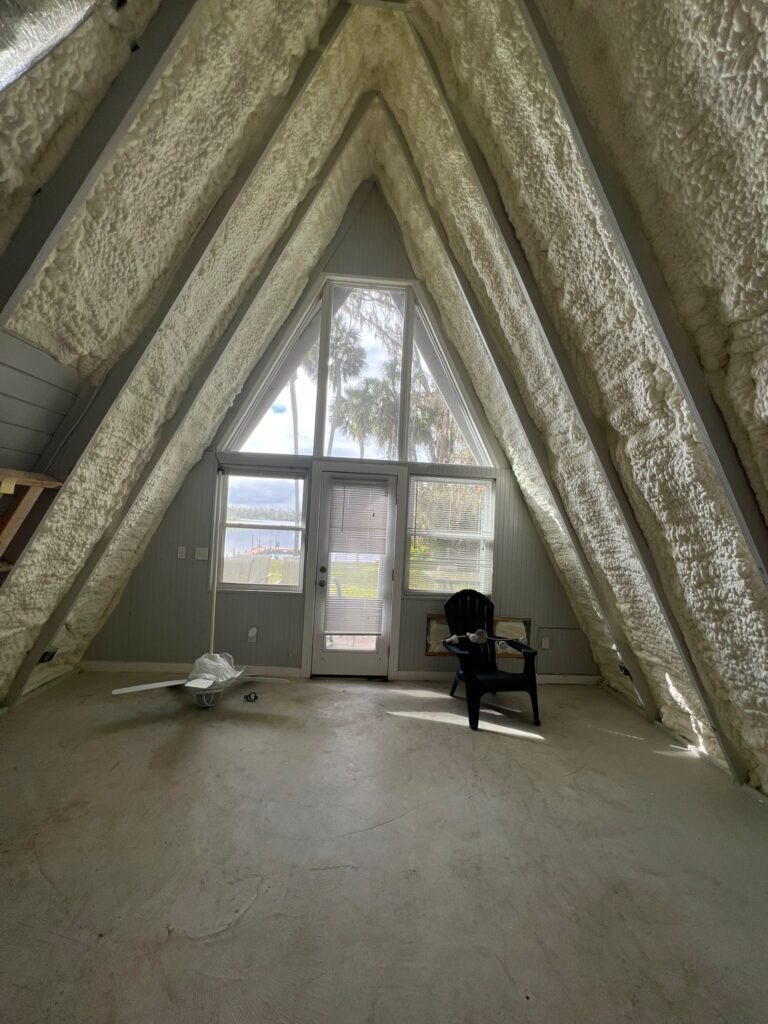Is Spray Foam Insulation Toxic?

Is spray foam harmful—or surprisingly safe?
Spray foam is one of the best materials for sealing air leaks and improving energy efficiency. But there’s one question we hear all the time:
Is spray foam toxic?
In this post, we break down:
- What spray foam is made of
- When and why it can be hazardous
- How GreenGuard Gold certification makes a difference
- Why we use Accufoam — a trusted, certified low-emission product
Let’s clear the air (literally).
What Is Spray Foam Insulation Made Of?
Spray foam insulation is made by combining two main ingredients:
- Polyol resin
- Isocyanates (MDI)
When mixed, they expand into foam and cure into either open-cell or closed-cell insulation. This process is what makes it so effective — but also what raises health concerns during installation.
Is Spray Foam Toxic During Installation?
Yes — but only during application.
When the foam is being sprayed and curing, it can emit:
- VOCs (volatile organic compounds)
- Unreacted isocyanates (which can irritate the skin, lungs, and eyes)
That’s why certified installers wear full protective gear and why we recommend that homeowners and pets vacate the space for 24–48 hours during and after spraying. After that, the product is safe and fully cured.
Is Spray Foam Safe After It Cures?
Yes. Once properly cured, high-quality spray foam becomes inert — it no longer emits harmful chemicals or odors.
Air quality studies confirm that VOC levels drop significantly once the foam has set, especially when certified products are used.
What Is GreenGuard Gold Certification?
GreenGuard Gold is an independent certification from UL that ensures building materials meet strict standards for low chemical emissions. This certification is especially important for schools, healthcare settings, and homes.
To earn GreenGuard Gold certification, spray foam must:
- Emit very low VOCs
- Pass tests for over 360 different chemicals
- Meet rigorous safety standards for indoor air quality
We Use Accufoam — GreenGuard Gold Certified
At Truly Sealed, we exclusively use Accufoam, a spray foam product that meets GreenGuard Gold certificationstandards.
Here’s why:
- It’s been independently tested for low emissions
- It’s safe for homes with children, pets, and sensitive individuals
- It performs exceptionally well in both insulation and air sealing
You get both safety and performance — no compromises.
How to Minimize Health Risks with Spray Foam
To make sure your spray foam install is safe:
- Use licensed, experienced installers (like us)
- Choose GreenGuard Gold–certified products
- Ventilate well during and after installation
- Wait 24–48 hours before reentering the space
How Does Spray Foam Compare to Other Insulation?
🔹 Spray Foam (GreenGuard Gold Certified)
- Off-Gassing Risk: Low (after curing)
- Mold Resistance: Excellent
- R-Value per Inch: High
- Moisture Barrier: Yes
- Health Concerns: Safe once cured
🔹 Fiberglass Batts
- Off-Gassing Risk: None
- Mold Resistance: Moderate
- R-Value per Inch: Moderate
- Moisture Barrier: No
- Health Concerns: Possible carcinogen (airborne fibers)
🔹 Cellulose
- Off-Gassing Risk: Low
- Mold Resistance: Low
- R-Value per Inch: Moderate
- Moisture Barrier: No
- Health Concerns: Can irritate lungs or cause dust issues
Note: The International Agency for Research on Cancer (IARC) has classified certain fiberglass products as “possible human carcinogens.” While modern fiberglass is safer, installation or disturbance can still expose you to harmful airborne fibers.
Frequently Asked Questions
Is spray foam toxic after installation?
No — once it cures, especially if it’s a certified product like Accufoam, spray foam is safe for indoor use.
Can spray foam make you sick?
Only if you’re exposed to it during installation. After the foam has cured, it becomes safe and stable.
Is fiberglass insulation really a carcinogen?
Fiberglass was once classified as a possible carcinogen due to airborne fibers. Modern products are safer, but it’s still a concern during installation or if damaged.
Is spray foam safer than fiberglass?
Yes. Certified closed-cell spray foam doesn’t release fibers, resists moisture, and is safer after curing — especially with GreenGuard Gold certification.
Conclusion: Choose Certified Foam, Installed Right
When it’s installed properly using a product like Accufoam, spray foam insulation is not only non-toxic — it’s one of the safest and most effective insulation materials available today.
Want to learn more or get help with your project?
Contact us for honest advice, product info, or a personalized estimate.
We’re here to help you build smarter, safer, and more efficient spaces.
